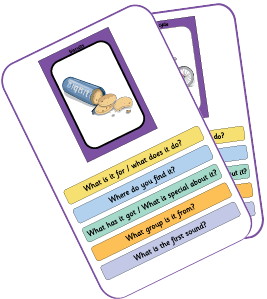Vocabulary is the foundation for developing oral and written language skills. Sarah Wall explains why everything comes back to the words we know.
Without good vocabulary skills we cannot take in new information or use this information in our learning. By developing vocabulary skills a child’s ability to learn and make sense of the world increases.
The key role vocabulary plays in a child’s development is highlighted in the report by the expert panel for the National Curriculum review, which states:
The development of oral language should be a strong feature of the new National Curriculum. Oral language skills including phonological awareness, oral vocabulary and syntactic knowledge are inextricably linked to reading skills and reading comprehension.
Department for Education (2011)
Why vocabulary?
It is well established that vocabulary is a strong predictor of academic and reading success. Cunningham & Stanovich (1997) found children’s vocabulary at only 5 years of age is the best predictor of reading comprehension at 10 years.
Weak vocabulary skills trap children in a v1c1ous circle, since the children who cannot read and comprehend what they read miss out on opportunities to extend their vocabulary through reading (DCSF ‘Teaching effective vocabulary’, 2008).
The existence of this cycle means that children with low vocabularies need to be targeted early = catching up is very difficult.
Department for Children, Schools and Families (DCSF), 2008
Children, particularly those from socially disadvantaged backgrounds, who enter school with poor vocabularies also have poor word learning skills. Block and Mangieri (2006) consider this lack of vocabulary to underlie academic failure for many pupils.
Although there is clear evidence that vocabulary development is crucial for school success, it does not receive the attention that work on literacy does and many teachers feel ill-equipped to help pupils improve oral vocabulary skills.
What are vocabulary skills?
Vocabulary skills are the skills needed to recognise, store, select and use words as well as understand them. This is also called semantic knowledge.
An individual’s vocabulary is like hundreds of filing cabinets full of words. Without a good index system, it takes a lot of time and effort to store or retrieve anything. Use key questions to help pupils to establish an efficient index system.
Teaching vocabulary skills
Children who struggle to learn new words fail because they do not make the essential semantic representations (Alt, et al, 2004). So the problem goes beyond learning the labels for words; it extends to acquiring the details of word meanings.
When working on vocabulary it is important to teach pupils to think about the meanings of words in a variety of ways. The more ways a pupil can do this, the more likely they are to store the word and be able to use it when they need to. Use the following key questions to encourage pupils to think about word meanings.
- Function – what does it do? This is used mostly for noun vocabulary. Children will instinctively use this when describing a word.
- Attributes and parts – what is it like? What are its special features? Use as much description as possible to explore the words as fully as possible.
- Categorisation – what other things are like it? Work on grouping things into categories and sub-categories, e.g. animals and pets. Emphasise why things belong together.
- Phonological Information – what is the first sound? Is it a long or short word? The sounds within a word are a powerful link to the word itself.
- Children need to experience words in as many different contexts as possible. Try to identify words that are likely to cause problems and work on those before the child needs them in a lesson. Use the same word in lots of contexts and different sentence constructions. Remember to use lots of repetition and explain the links between words in terms of similarities and differences. Some activity ideas are given here.
- Fill the gap – Cover up a few ‘information’ words in a reading book. Think of possible words and then choose the appropriate word to fill the gap, e.g. Katie went shopping, she ____ down the road.
- Feely bag – Put some everyday items in a bag. Each pupil takes a turn to take an item from the bag. The pupils must answer some questions about the item to describe it, e.g. what colour is it?, what do we use it for?, etc. This game works really well when it is linked to classroom topics.
- Categories – Write different categories on cards, e.g. hot food, red things, metal things, etc. Each child takes a turn to choose a card. Then ask them to roll a dice and name that number of items in the category, e.g. if they roll 3 then name three things.
- Describing Cue Card – This Junior Language Link resource breaks down word descriptions into core skills. Put a word or picture at the top and children answer the questions.

Junior Language Link Describing Cue Cards
References
Alt, M., Plante, E. & Creusere, M. (2004) Semantic Features in Fast-Mapping: Performance of Preschoolers With Specific Language Impairment Versus Preschoolers With Normal Language, Journal of Speech, Language, and Hearing Research, 47: 407-420.
Block, C.C. & Mangieri, J.N. (2006) The Effects of Powerful Vocabulary for Reading Success on Students’ Reading Vocabulary and Comprehension Achievement. Research Report 2963-005, Institute for Literacy Enhancement
Cunningham, A.E. & Stanovich, K.E. (1997) Early reading acquisition and it’s relation to reading experience and ability 10 years later. Developmental Psychology, 33: 934-945.
Department for Children, Schools & Families (DCSF, 2008) Teaching Effective Vocabulary. Accessed December 2012. Available online at http://tinyurl.com/bv9r2on.
Department for Education (DfE, 2011 ). The Framework for the National Curriculum. A report by the Expert Panel for the National Curriculum review. London: Department for Education.
Please login to view this content
Login